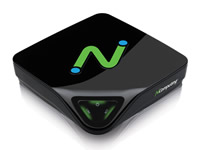« India - The Dynamic Duo | Main | Cisco announces virtual desktops for video collaboration »
November 15, 2010
Reviews - ZDNet UK - NComputing L300
 Review: NComputing's L300 is an excellent desktop provisioning option for small and medium-sized organisations requiring thin clients and managed desktops without the complexity of full-blown Terminal Services or VDI. Review: NComputing's L300 is an excellent desktop provisioning option for small and medium-sized organisations requiring thin clients and managed desktops without the complexity of full-blown Terminal Services or VDI. |
NComputing L300 Review | Thin Clients | ZDNet UK
Launched in April, the NComputing L300 is a zero-footprint thin-client for small and medium-sized deployments. Rather than rely on a hypervisor such as VMware ESXi or Microsoft's Hyper-V, the L300 is designed for use with NComputing's vSpace software to provide Terminal Services-style desktops for LAN-based users.
The L300, which has an 11.5cm-square foorprint, has a good set of connections for a thin client: 2 x USB 2.0 (for peripherals); microphone and headphone; 2 x USB 1.1 (for keyboard and mouse); 10/100Mbps Ethernet, VGA, 12V DC in, on/off
vSpace can be installed on servers running 32-bit versions of Windows Server 2003 and 2008, and Ubuntu Linux. If you're using Windows Server 2008 R2, you'll have to wait for the next vSpace release, which is expected to support 64-bit versions of Windows.
We installed vSpace on a server running Windows Server 2003 R2. vSpace does not require Microsoft Terminal Services or a Microsoft Terminal Services License Server to be running, which makes the server-side setup straightforward.
In contrast to enterprise-level VDI systems, the price structure for NComputing L300 is also refreshingly simple. You buy as many L300 client devices as you want, and NComputing's vSpace management software and all software updates are free. Prices for the L300 hardware start at £180 (ex. VAT), with discounts available for bulk orders.
NComputing's (currently 32-bit only) vSpace software provides Terminal Services-style desktops for up to 30 LAN-based L300 users per server or host PC
To install and roll out applications, you use much the same process as Microsoft Terminal Services: that is, a server administrator installs whatever apps are needed on the server, and provided the apps work properly in a Terminal Services setup, they will immediately become available to users.
For example, we installed Skype on our server and as soon as the installation was complete, a new Skype icon was automatically added to our L300 users' Windows Start menus.
Adding a new L300 to your LAN is as simple as plugging it in. The device will get its IP address from a DHCP server, and will automatically discover any vSpace servers on the LAN. Something to bear in mind when adding or relocating users is that although NComputing describes the L300 as a zero-footprint client, it does actually contain some firmware and can hold some user preference data.
We found the L300 took around 40 seconds to boot in our tests. Depending on how the L300 is configured, on boot-up the user will either be automatically connected to their chosen vSpace server or they will see an on-screen menu allowing them to enter their Windows username and the server they want to connect to.
In our tests we simply created new users on the Windows Server and added them to the Remote Desktop Users group. This workflow is somewhat simpler than the equivalent needed to add a new user to a full VDI environment.
Administration on the server is carried out using the vSpace Console, which is launched by double clicking its icon in the Windows System Tray and entering a password.
Based on the familiar Microsoft Management Console architecture, the vSpace Console is easy to navigate. For example, we could expand hierarchies such as Hardware Settings to get a list of client devices, and adjust settings for individual clients using the device's Properties screen.
NComputing L300 Review | Thin Clients | ZDNet UK
Posted by Staff at November 15, 2010 09:10 PM